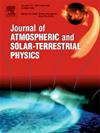Aerosol Optical Properties and its radiative effects over two topographically different locations of the Indian Himalayan Region
IF 1.8
4区 地球科学
Q3 GEOCHEMISTRY & GEOPHYSICS
Journal of Atmospheric and Solar-Terrestrial Physics
Pub Date : 2025-03-01
DOI:10.1016/j.jastp.2025.106487
引用次数: 0
Abstract
This study investigates aerosol characteristics using ground-based measurements at two distinct regions, Mohal-Kullu (31.9°N, 77.12°E; 1154 m amsl) and Kosi-Katarmal (29.64°N, 79.62°E; 1225 m amsl), from July 2019 to June 2022. The average Black Carbon (BC) concentrations were 1.5 ± 1.0 μg m−3 at Mohal and 1.1 ± 1.4 μg m−3 at Katarmal. BC showed strong seasonal variability, with maxima during post-monsoon (2.6 ± 1.0 μg m−3) and pre-monsoon (1.8 ± 0.5 μg m−3) seasons. The diurnal variation displayed distinct morning and evening peaks in all the seasons. High pre-monsoon AOD500 (0.30 ± 0.06 to 0.54 ± 0.08) and low values of Ångström exponent (0.67 ± 0.10 to 0.95 ± 0.30) indicated dominance of large particles, whereas lower AOD500 (0.21 ± 0.07 to 0.25 ± 0.03) in post-monsoon and winter, along with larger Ångström exponent (1.05 ± 0.74 to 1.13 ± 0.11), indicated smaller particles. Satellite-derived (OMI and MAIAC) AOD500 showed weak to moderate correlation with ground-based measurements at Mohal (R = 0.4639 for MAIAC, R = 0.1402 for OMI) and Katarmal (R = 0.3976 for MAIAC, R = 0.2980 for OMI). Using optical properties of aerosols and clouds (OPAC) and Santa Barbara discrete ordinate radiative transfer (SBDART) models, the short-wave aerosol radiative forcing (SWARF) was found negative at the surface and top of the atmosphere but positive in the atmosphere, suggesting significant surface cooling and atmospheric warming leading to high heating rates, respectively. Annual mean atmospheric radiative forcing was 27.36 ± 6.00 Wm−2 at Mohal and 21.87 ± 7.26 Wm−2 at Katarmal. These findings may have consequences for planning air pollution strategies and understanding the effects of regional climate change.
求助全文
约1分钟内获得全文
求助全文
来源期刊

Journal of Atmospheric and Solar-Terrestrial Physics
地学-地球化学与地球物理
CiteScore
4.10
自引率
5.30%
发文量
95
审稿时长
6 months
期刊介绍:
The Journal of Atmospheric and Solar-Terrestrial Physics (JASTP) is an international journal concerned with the inter-disciplinary science of the Earth''s atmospheric and space environment, especially the highly varied and highly variable physical phenomena that occur in this natural laboratory and the processes that couple them.
The journal covers the physical processes operating in the troposphere, stratosphere, mesosphere, thermosphere, ionosphere, magnetosphere, the Sun, interplanetary medium, and heliosphere. Phenomena occurring in other "spheres", solar influences on climate, and supporting laboratory measurements are also considered. The journal deals especially with the coupling between the different regions.
Solar flares, coronal mass ejections, and other energetic events on the Sun create interesting and important perturbations in the near-Earth space environment. The physics of such "space weather" is central to the Journal of Atmospheric and Solar-Terrestrial Physics and the journal welcomes papers that lead in the direction of a predictive understanding of the coupled system. Regarding the upper atmosphere, the subjects of aeronomy, geomagnetism and geoelectricity, auroral phenomena, radio wave propagation, and plasma instabilities, are examples within the broad field of solar-terrestrial physics which emphasise the energy exchange between the solar wind, the magnetospheric and ionospheric plasmas, and the neutral gas. In the lower atmosphere, topics covered range from mesoscale to global scale dynamics, to atmospheric electricity, lightning and its effects, and to anthropogenic changes.
 求助内容:
求助内容: 应助结果提醒方式:
应助结果提醒方式:


